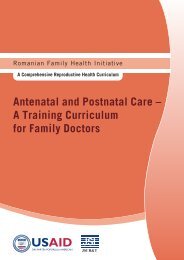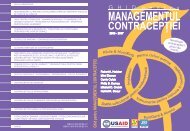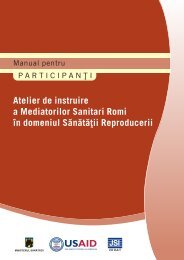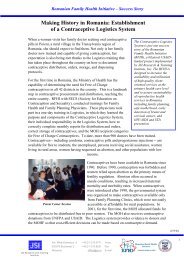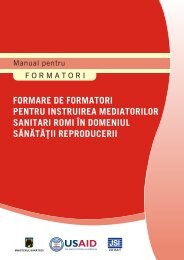Training of Roma Health Mediators in Reproductive Health
Training of Roma Health Mediators in Reproductive Health
Training of Roma Health Mediators in Reproductive Health
Create successful ePaper yourself
Turn your PDF publications into a flip-book with our unique Google optimized e-Paper software.
‣ How can you tell if a baby is not suckl<strong>in</strong>g effectively?<br />
• The baby takes quick shallow sucks all the time.<br />
• The baby makes smack<strong>in</strong>g sounds as he sucks.<br />
‣ What are the consequences <strong>of</strong> poor attachment?<br />
Correct participant responses if necessary.<br />
Poor attachment will cause:<br />
• Sore and cracked nipples, either across the tip <strong>of</strong> the nipple or around its base<br />
• Poor reflex to the mother, lead<strong>in</strong>g to poor milk production<br />
• Breast engorgement<br />
• Fussy, cry<strong>in</strong>g baby who wants to feed very frequently because he is unsatisfied<br />
• Poor weight ga<strong>in</strong><br />
• Possibly refusal to suck because baby is frustrated<br />
• Low milk production because the breasts are not properly emptied.<br />
The eventual result may be breastfeed<strong>in</strong>g failure.<br />
Emphasize that the mother needs to know how to check if the baby seem satisfied. She<br />
should look for these signs:<br />
• The baby releases the breast himself.<br />
• He/she look<strong>in</strong>g satisfied and sleepy. This shows that he has had all that he wants from<br />
that side. He may or may not want the other side too.<br />
If the mother takes her baby <strong>of</strong>f her breast quickly as soon as he pauses, because she<br />
th<strong>in</strong>ks he has f<strong>in</strong>ished or because she wants to make sure that he suckles from the other<br />
side as well, the baby may not have gotten enough h<strong>in</strong>d milk and he may want to feed<br />
aga<strong>in</strong> soon.<br />
The exact length <strong>of</strong> time is not important. Feeds normally vary very much <strong>in</strong> length.<br />
However:<br />
• If breastfeeds are very long (more than about half an hour) or very short (less than<br />
about 4 m<strong>in</strong>utes) it may mean that there is a problem.<br />
• In the first few days, or with a low-birth-weight baby, breastfeeds may be very<br />
long and this is normal<br />
It is also important to ask the mother how breastfeed<strong>in</strong>g feels to her:<br />
• If it is comfortable and pleasant, her baby is probably well attached.<br />
• If it is uncomfortable or pa<strong>in</strong>ful, the baby is probably not well attached.<br />
Summarize:<br />
Breastfeed<strong>in</strong>g will be successful <strong>in</strong> most cases if:<br />
• The mother feels good about herself.<br />
• The baby is well attached to the breast so that he suckles effectively.<br />
148<br />
RFHI/JSI <strong>Roma</strong>nia <strong>Tra<strong>in</strong><strong>in</strong>g</strong> <strong>of</strong> RHMs <strong>in</strong> <strong>Reproductive</strong> <strong>Health</strong> Session 9: Breastfeed<strong>in</strong>g



